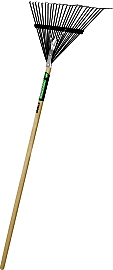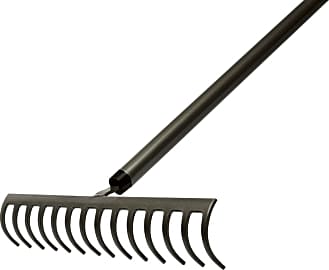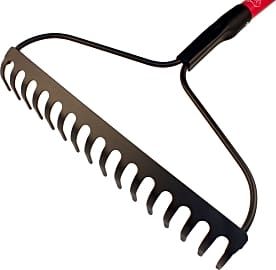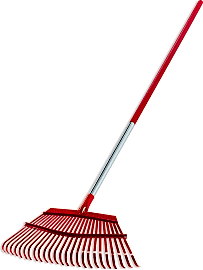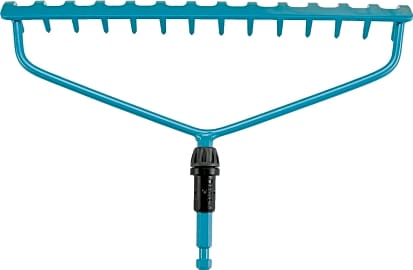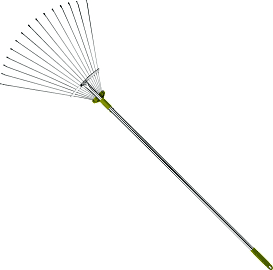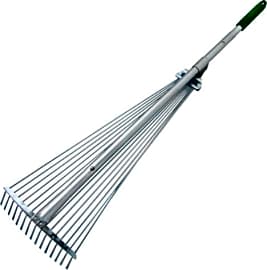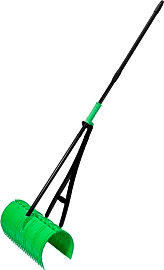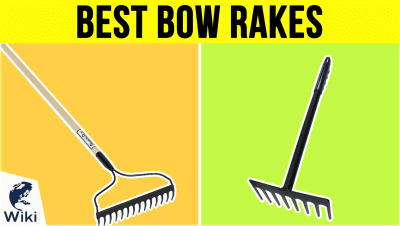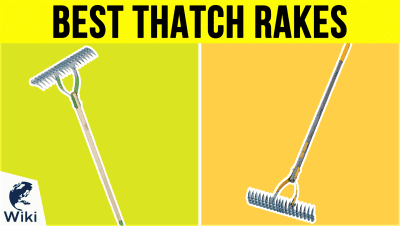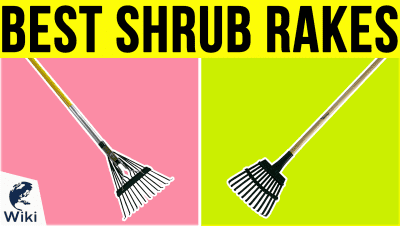The 10 Best Garden Rakes

This wiki has been updated 41 times since it was first published in October of 2015. Gather grass clippings, brush, leaves, mulch and other debris quickly and easily with one of these versatile garden rakes. They're also handy for clearing rows for cultivation, smoothing out landscaping elements, and gently incorporating soil amendments. We have included both traditional versions and some interesting new takes on the classic design that you may want to consider. When users buy our independently chosen editorial picks, we may earn commissions to help fund the Wiki.
Editor's Notes
June 24, 2020:
Removed the Oxo Good Grips Adjustable and the Radius Mini Ground Hog because of availability issues. Added the A.M. Leonard Traditional Bow and the Truper 30480 Tru Tough.
We took some liberty in including a few different types of rakes within the category of 'garden rake'. What most people think of when mentioning a garden rake is wide and splayed rakes like the Truper 30480 Tru Tough. We included several bow rakes like the Fiskars Ergo because many people use them for the same purposes and they are also often identified as garden rakes. But there are many categories of rake such as thatch rakes, shrub rakes, and others.
For many tools, including gardening tools, I tend to favor wooden handles like that on the A.M. Leonard Traditional Bow. The relevant properties in rakes are that handle woods like ash and hickory are plenty strong for raking tasks while being lighter and more comfortable than both steel and aluminum. Fiberglass handles like that on the Bully Tools 92309 are also lightweight but once the handle breaks, the tool is useless and must be thrown away. If you have a nice forged head like on the A.M. Leonard, it would be a shame to just throw it away, which is why they use wood - instead of discarding the whole tool, you have the option of replacing the handle.
Why It's Important To Invest In A Quality Rake
As the seasons change, new chores arise, and without a decent rake, caring for outdoor areas properly can be difficult, if not impossible.
It's no secret that lawns, backyards, and gardens require plenty of maintenance to keep them looking their best. So, if you don't already have a reliable rake in your shed, you're going to want to pick one up sooner rather than later. As the seasons change, new chores arise, and without a decent rake, caring for outdoor areas properly can be difficult, if not impossible. Here are the main reasons to invest in the tool that has proven its worth over centuries.
First, it's true: the rake has been a staple of horticulture for quite a while. The rake was created in Chinaover 1,500 years ago, during the reign of the Northern Wei Dynasty, as a response to the harrow — a similarly toothed, but cumbersome tool intended to be pulled by livestock. Though there have been developments in the technology since it first made its appearance, the rake is still very much in style thanks to its simple and effective design.
Rakes are versatile, too. If you have trees in your yard that shed their leaves in the fall, a rake will serve as your first line of defense against a messy, unsightly lawn. They're also perfect for creating even rows for seed planting, and for loosening and aerating garden soil. You can even use these nifty tools to work grass seed or fertilizer into your lawn-in-progress.
It pretty much goes without saying that rakes are remarkably easy and intuitive to operate. As long as you're strong enough to sweep with a broom, you will be more than able to clean up your front yard or till your garden's soil with a rake. Plus, gardening is a wonderful activity for maintaining fitness and mental health at any age, and long-handled tools like these allow gardeners with back problems to remain upright while they work, thereby preventing strain and discomfort.
As you can see, the rake is not only practical, but dynamic. It's a time-tested tool that can come in handy for a variety of outdoor tasks, and there's no assembly or time-consuming maintenance required. Virtually anyone can operate a rake, which is what makes it one of the most widely used tools on earth.
Features To Look For
The rake's design may be minimalist, but that doesn't mean that the options out there are limited. Small differences among models make a big difference in the yard, so it's important to choose the product that will best address your specific needs.
You can also opt for an adjustable rake with a telescoping handle, which allows for a super-customized length.
As you shop, think about the construction of the rake and whether a metal or plastic model would be more suitable for the tasks you have in mind. Plastic rakes tend to weigh less than metal ones and are often less expensive, though some people find that they damage too easily. Metal rakes, on the other hand, are appropriate for use on dense materials like mulch, tightly packed dirt, and even rocks. They make a great choice for professional gardeners and horticulturalists, and those who perform yard maintenance on a frequent basis.
Rakes are generally a one-size-fits-all product, but there are definitely exceptions. If you're concerned about comfort and preserving joint health, search for options that come in multiple sizes. Commonly, lengths range between 40 and 70 inches. You can also opt for an adjustable rake with a telescoping handle, which allows for a super-customized length. Some adjustable models can be collapsed almost completely to double as hand rakes for gardening.
The distance between the rake's teeth is another detail to review. Rakes with teeth that are closer together are better for debris made up of smaller pieces, like gravel. Larger debris, and debris that sticks together in big clumps (like grass clippings, for instance), can be tackled using a tool with teeth that are set farther apart. There are adjustable models available that fan out wide for big jobs and collapse for tight spaces, smaller debris, and easy storage.
To recap, make note of the rake's construction, handle length, and teeth before you pull the trigger on your purchase. With the right equipment, your list of outdoor chores will be finished in no time.
Tips For Efficient Raking
If raking the lawn each fall is one of the seasonal tasks you hate most, you're not the only one. These techniques should help you streamline your cleanup process, so you can get back to enjoying the indoors.
These techniques should help you streamline your cleanup process, so you can get back to enjoying the indoors.
It may seem obvious, but before you begin raking with reckless abandon, check the weather. Avoid doing yard work when conditions are windy, and be sure that the leaves or grass clippings you intend to collect are dry. Moisture adds extra weight to foliage and can make it sticky and difficult to work with. Gathering everything up is hard as it is, so choose a day that is calm and sunny so the job can be completed in one go and without any frustrating setbacks.
Don't waste your time transferring every single leaf to the same spot right away. A smart approach is to make piles in every section of the lawn. Once all unwanted debris has been accounted for, you can combine those smaller piles to create one big heap. This will cut down on the time it takes to finish raking by quite a bit, and it will also help you conserve your energy — an especially relevant note for those clearing larger areas.
You will likely need more than just a rake to get the job done. Consider investing in gloves and a mask to keep your hands and face protected from dirt, splinters, dust, and chemicals. You will certainly need extra-large trash bags for disposal. If you're planning on using the organic waste you've collected for composting, there are bags on the market that biodegrade over a short period of time and can be safely (and conveniently) included in your compost bin.
In short, with a sturdy rake on hand and these easy-to-follow tips in your back pocket, restoring your front yard to its original glory will be a smooth — and even enjoyable — experience. After all, you can't put off your chores forever.


